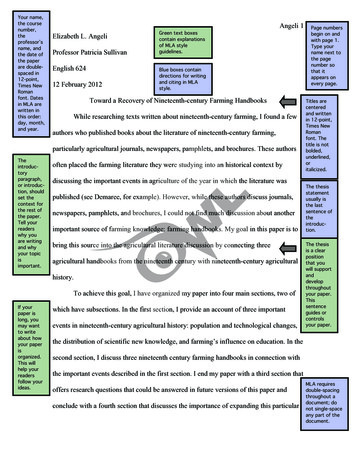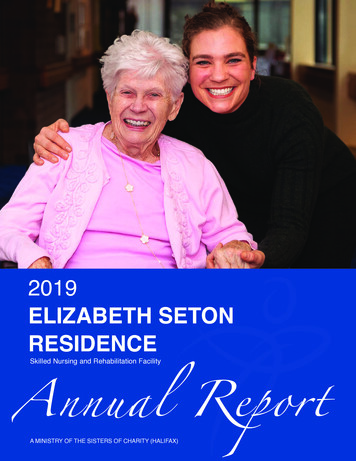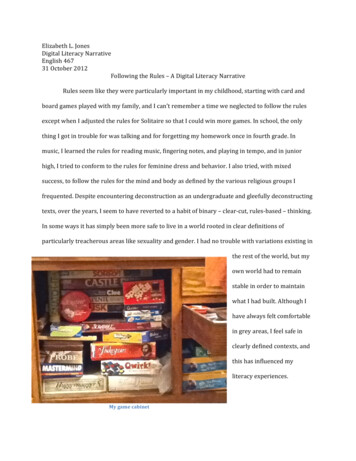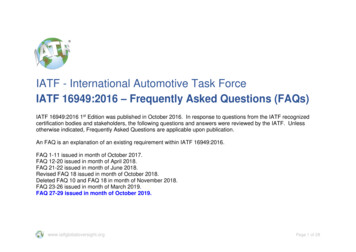
Transcription
Your name,the coursenumber,theprofessor’sname, andthe date ofthe paperare doublespaced in12-point,Times NewRomanfont. Datesin MLA arewritten inthis order:day, month,and year.Elizabeth L. AngeliProfessor Patricia SullivanEnglish 62412 February 2012Angeli 1Green text boxescontain explanationsof MLA styleguidelines.Blue boxes containdirections for writingand citing in MLAstyle.Toward a Recovery of Nineteenth-century Farming HandbooksWhile researching texts written about nineteenth-century farming, I found a fewauthors who published books about the literature of nineteenth-century farming,particularly agricultural journals, newspapers, pamphlets, and brochures. These authorsTheintroductoryparagraph,or introduction, shouldset thecontext forthe rest ofthe paper.Tell yourreaderswhy youare writingand whyyour topicisimportant.often placed the farming literature they were studying into an historical context bydiscussing the important events in agriculture of the year in which the literature waspublished (see Demaree, for example). However, while these authors discuss journals,newspapers, pamphlets, and brochures, I could not find much discussion about anotherimportant source of farming knowledge: farming handbooks. My goal in this paper is tobring this source into the agricultural literature discussion by connecting threeagricultural handbooks from the nineteenth century with nineteenth-century agriculturalhistory.To achieve this goal, I have organized my paper into four main sections, two ofIf yourpaper islong, youmay wantto writeabout howyour paperisorganized.This willhelp yourreadersfollow yourideas.which have subsections. In the first section, I provide an account of three importantevents in nineteenth-century agricultural history: population and technological changes,Page numbersbegin on andwith page 1.Type yourname next tothe pagenumber sothat itappears onevery page.Titles arecenteredand writtenin 12-point,Times NewRomanfont. Thetitle is notbolded,underlined,oritalicized.The thesisstatementusually isthe lastsentence oftheintroduction.The thesisis a clearpositionthat youwill supportanddevelopthroughoutyour paper.Thissentenceguides orcontrolsyour paper.the distribution of scientific new knowledge, and farming’s influence on education. In thesecond section, I discuss three nineteenth century farming handbooks in connection withthe important events described in the first section. I end my paper with a third section thatoffers research questions that could be answered in future versions of this paper andconclude with a fourth section that discusses the importance of expanding this particularMLA requiresdouble-spacingthroughout adocument; donot single-spaceany part of thedocument.
Angeli 2project. I also include an appendix before the Works Cited that contains images of thethree handbooks I examined. Before I can begin the examination of the three handbooks,Usepersonalpronouns (I,we, us,etc.) atyourinstructor’sdiscretion.however, I need to provide an historical context in which the books were written, and it isto this that I now turn.When using headings inMLA, title the mainsections (B-level headers)in a different style fontthan the paper’s title, e.g.,in small caps.This is a Blevelheading.Historical ContextThe headings used here follow an A-, B-, C-levelsystem to break the text into smaller sections.The different levels help organize the paper andmaintain consistency in the paper’sorganization. You may come up with your ownheadings as long as they are consistent.The nineteenth-century saw many changes to daily American life with an increasein population, improved methods of transportation, developments in technology, and therise in the importance of science. These events impacted all aspects of nineteenth-centuryAmerican life, most significantly those involved in slavery and the Civil War, but a largepart of American life was affected, a part that is quite often taken for granted: the life ofthe American farmer.This is a Clevelheading.Headers,though notrequired byMLA style,help theoverallstructureandorganization of apaper. Usethem atyourinstructor’sdiscretionto helpyour readerfollow yourideas.Population and Technological Changes. One of the biggest changes, as seen innineteenth-century America’s census reports, is the dramatic increase in population. TheUseanotherstyle, e.g.,bold-faced,todifferentiate the Clevelheadersfrom the Blevelheaders.Theparagraphcontinuesdirectlyafter theheader.1820 census reported that over 10 million people were living in America; of those 10million, over 2 million were engaged in agriculture. Ten years prior to that, the 1810census reported over 7 million people were living in the states; there was no category forpeople engaged in agriculture. In this ten-year time span, then, agriculture experiencedsignificant improvements and changes that enhanced its importance in American life.One of these improvements was the developments of canals and steamboats,If there is agrammatical,mechanical,or spellingerror in thetext youare citing,type thequote as itappears.Follow thequote with“[sic].”which allowed farmers to “sell what has previously been unsalable [sic]” and resulted in a“substantial increase in [a farmer’s] ability to earn income” (Danhof 5). Thisimprovement allowed the relations between the rural and urban populations to strengthen,resulting in an increase in trade. The urban population (defined as having over 2,500inhabitants) in the northern states increased rapidly after 1820.1 This increaseInsert the footnote directlyafter the phrase or clause towhich it refers.Usefootnotesto explain apoint inyour paperthat doesnot quitefit in withthe rest oftheparagraph.
Angeli 3accompanied the decrease in rural populations, as farmers who “preferred trade,transportation, or ‘tinkering’” to the tasks of tending to crops and animals found greatopportunities in the city (Danhof 7). Trade and transportation thus began to influenceIn-textcitationsoccur afterthe quotebut beforethe period.Theauthor’s/authors’name/s gobefore thepagenumberwith nocomma inbetween.farming life significantly. Before 1820, the rural community accounted for eighty percentof consumption of farmers’ goods (Hurt 127). With the improvements in transportation,twenty-five percent of farmers’ products were sold for commercial gain, and by 1825,farming “became a business rather than a way of life” (128). This business requiredfarmers to specialize their production and caused most farmers to give “less attention tothe production of surplus commodities like wheat, tobacco, pork, or beef” (128). Theincrease in specialization encouraged some farmers to turn to technology to increase theirproduction and capitalize on commercial markets (172).Development of TechnologiesThis is a Dlevelheading.Use another style, e.g., bold andflush left, to differentiate the Dlevel headers from the C-levelheaders.The technology farmers used around 1820 was developed from three mainsources. First, developments that took place in Europe with the development of industrycontinued to impact farming practices worldwide. Second, farmers looked to thetechniques developed by coastal Indian tribes in America for expertise, since thesetechniques were created for the crops and climates unique to the Americas. Finally,Footnotesshould bedoublespaced andin size 12Times NewRomanfont.domestic modifications made from the first two sources’ technologies were engineeredby American farmers themselves to meet the farmers’ specific needs. Through time,technology improved, and while some farmers clung to their time-tested technologies,others were eager to find alternatives to these technologies. These farmers often turned tocurrent developments in Great Britain and received word of their technologicalimprovements through firsthand knowledge by talking with immigrants and travelers.
If youdeletewords fromthe originalquote,insert anellipsis,threeperiodswith aspacebetweenand aftereach one.Spread of TechnologiesAngeli 4In addition to gaining information from overseas, farmers also began planning andconducting experiments, and although they lacked a truly scientific approach, thesefarmers engaged in experiments to obtain results and learn from the results.2 Agriculturalorganizations were then formed to “encourage . . . experimentation, hear reports, observeresults, and exchange critical comments” (Danhof 53). Thus, new knowledge wastransmitted orally from farmer to farmer, immigrant to farmer, and traveler to farmer,which could result in the miscommunication of this new scientific knowledge. Therefore,Bodyparagraphshave thesefourelements: atransition, atopicsentence,evidence,and a briefwrap-upsentence.developments were made for knowledge to be transmitted and recorded in a morepermanent, credible way: by print.The Distribution of New Knowledge. Before 1820 and prior to the newknowledge farmers were creating, farmers who wanted print information aboutagriculture had their choice of agricultural almanacs and even local newspapers to receiveinformation (Danhof 54). After 1820, however, agricultural writing took more forms thanNotice howthisparagraphbegins witha transition.The topicsentencefollows thetransition,and it tellsreaderswhat theparagraphis about.Directquotes areused tosupportthis topicsentence.Transitionsconnectparagraphsand unifywriting.Notice howthisparagraphends with abriefmention ofprintsources andthe nextparagraphbegins withadiscussionof printinformation.almanacs and newspapers. From 1820 to 1870, agricultural periodicals were responsiblefor spreading new knowledge among farmers. In his published dissertation The AmericanAgricultural Press 1819-1860, Albert Lowther Demaree presents a “description of thegeneral content of [agricultural journals]” (xi). These journals began in 1819 and werewritten for farmers, with topics devoted to “farming, stock raising, [and] horticulture”(12). The suggested “birthdate” of American agricultural journalism is April 2, 1819when John S. Skinner published his periodical American Farmer in Baltimore. Demareewrites that Skinner’s periodical was the “first continuous, successful agriculturalperiodical in the United States” and “served as a model for hundreds of journals thatsucceeded it” (19). In the midst of the development of the journal, farmers began writingTitles ofpublishedworks(books,journals,films, etc.)are nowitalicizedinstead ofunderlined.
Angeli 5handbooks. Not much has been written on the handbooks’ history, aside from the fact thatC. M. Saxton & Co. in New York was the major handbook publisher. Despite the lack ofTheparagraphends with awrap-upsentence,“Despitethelack . . .”,whiletransitioning tothe nextparagraph.information about handbooks, and as can be seen in my discussion below, thesehandbooks played a significant role in distributing knowledge among farmers and ineducating young farmers, as I now discuss.Farming’s Influence on Education. One result of the newly circulating printinformation was the “need for acquiring scientific information upon which could bebased a rational technology” that could “be substituted for the current diverse, empiricalpractices” (Danhof 69). In his 1825 book Nature and Reason Harmonized in the Practiceof Husbandry, John Lorain begins his first chapter by stating that “[v]ery erroneoustheories have been propagated” resulting in faulty farming methods (1). His words herecreate a framework for the rest of his book, as he offers his readers narratives of his owntrials and errors and even dismisses foreign, time-tested techniques farmers had held onto: “The knowledge we have of that very ancient and numerous nation the Chinese, aswell as the very located habits and costumes of this very singular people, is initselfinsufficient to teach us . . .” (75). His book captures the call and need for scientificexperiments to develop new knowledge meant to be used in/on/with American soil,which reflects some farmers’ thinking of the day.By the 1860s, the need for this knowledge was strong enough to affect education.John Nicholson anticipated this effect in 1820 in the “Experiments” section of his bookThe Farmer’s Assistant; Being a Digest of All That Relates to Agriculture and theUse blockquoteswhenquotationsare longerthan fourtyped lines.Conducting of Rural Affairs; Alphabetically Arranged and Adapted for the United States:Perhaps it would be well, if some institution were devised, and supportedat the expense of the State, which would be so organized as would tend
Blockquotesbegin on anew line,are doublespaced, andareindented 1”from themargin. Donot usequotationmarks. Thecitationinformation(authorname andpagenumber)follows thequote’s endpunctuation.Angeli 6most effectually to produce a due degree of emulation among Farmers, byrewards and honorary distinctions conferred by those who, by theirsuccessful experimental efforts and improvements, should renderthemselves duly entitled to them.3 (92)Part of Nicholson’s hope was realized in 1837 when Michigan established their stateuniversity, specifying that “agriculture was to be an integral part of the curriculum”(Danhof 71). Not much was accomplished, however, much to the dissatisfaction offarmers, and in 1855, the state authorized a new college to be “devoted to agriculture andto be independent of the university” (Danhof 71). The government became more involvedin the creation of agricultural universities in 1862 when President Lincoln passed theMorrill Land Grant College Act, which begins with this phrase: “AN ACT DonatingPublic Lands to the several States and Territories which may provide Colleges for theBenefit of Agriculture and Mechanic Arts [sic].” The first agricultural colleges formedPeriodsoccurbefore theendquotationmark if thecitationinformationis givenalready inthesentence.under the act suffered from a lack of trained teachers and “an insufficient base ofknowledge,” and critics claimed that the new colleges did not meet the needs of farmers(Hurt 193).Congress addr
Transitions connect paragraphs and unify writing. Body paragraphs have these four elements: a transition, a topic sentence, evidence, and a brief wrap-up sentence. Notice how this paragraph begins with a transition. The topic sentence follows the transition, and it tells readers what the paragraph is about. Direct quotes are used to support this topic sentence. Notice how this paragraph ends .











